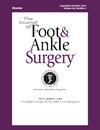What is the best: Functional rehabilitation or traditional immobilization after double-row suture anchor repair for insertional Achilles tendinopathy?
IF 1.3
4区 医学
Q2 Medicine
引用次数: 0
Abstract
This retrospective study compared two rehabilitation methods for patients who underwent a double-row surgical technique for Insertional Achilles Tendinopathy (IAT). Group 1 (G1) received traditional immobilization with casting and no weightbearing for six weeks, while Group 2 (G2) followed a modern functional rehabilitation program with early weightbearing in a walking boot. Data were analyzed from 63 patients (68 feet), with 48 patients (51 feet) in G1 and 17 patients (17 feet) in G2. The minimum follow-up was two years (mean of 32 months, ranging from two to nine years). Pre- and postoperative data, including VAS (Visual Analog Scale) pain scores and functional scores, were collected at six months and at the final follow-up. Additionally, return-to-work, driving, and sports data were evaluated.
Pre- and post-VAS scores for G1 were 7.49/1.39 and for G2 were 7.8/2.2, showing no significant difference (p = 0.89). The overall mean VAS improved from 7.56 to 1.58 postoperatively. The FAAM-ADL score was 81.68 points (88.28 %), with men experiencing statistically greater improvements than women. Patients in G2 returned to work, driving, and sports faster within the first six months. Although G2 initially had slightly higher functional scores, no significant differences were observed between the two groups after six months. Early functional rehabilitation facilitated a quicker return to daily activities without increasing pain but did not provide better long-term functional outcomes compared to traditional immobilization. Thus, early weightbearing aids short-term recovery but does not enhance functional scores beyond six months.
对于插入性跟腱病,双排缝线锚钉修复后功能康复和传统固定哪个最好?
本回顾性研究比较了采用双排手术技术治疗插入性跟腱病(IAT)患者的两种康复方法。1组(G1)接受传统的固定,铸造,不负重6周,而2组(G2)接受现代功能康复计划,早期步行靴负重。数据分析来自63名患者(68英尺),其中48名患者(51英尺)为G1, 17名患者(17英尺)为G2。最小随访时间为2年(平均32个月,2 - 9年不等)。在6个月和最后随访时收集术前和术后数据,包括VAS(视觉模拟量表)疼痛评分和功能评分。此外,对重返工作、驾驶和运动数据进行了评估。G1术前和术后vas评分为7.49/1.39,G2评分为7.8/2.2,差异无统计学意义(p=0.89)。术后VAS总分由7.56分提高至1.58分。FAAM-ADL评分为81.68分(88.28%),男性比女性有更大的改善。G2组患者在前六个月内恢复工作、驾驶和运动的速度更快。虽然G2最初的功能评分略高,但6个月后两组之间没有明显差异。早期功能康复有助于更快地恢复日常活动,而不会增加疼痛,但与传统固定相比,不能提供更好的长期功能结果。因此,早期负重有助于短期恢复,但不能提高超过6个月的功能评分。
本文章由计算机程序翻译,如有差异,请以英文原文为准。
求助全文
约1分钟内获得全文
求助全文
来源期刊

Journal of Foot & Ankle Surgery
ORTHOPEDICS-SURGERY
CiteScore
2.30
自引率
7.70%
发文量
234
审稿时长
29.8 weeks
期刊介绍:
The Journal of Foot & Ankle Surgery is the leading source for original, clinically-focused articles on the surgical and medical management of the foot and ankle. Each bi-monthly, peer-reviewed issue addresses relevant topics to the profession, such as: adult reconstruction of the forefoot; adult reconstruction of the hindfoot and ankle; diabetes; medicine/rheumatology; pediatrics; research; sports medicine; trauma; and tumors.
 求助内容:
求助内容: 应助结果提醒方式:
应助结果提醒方式:


